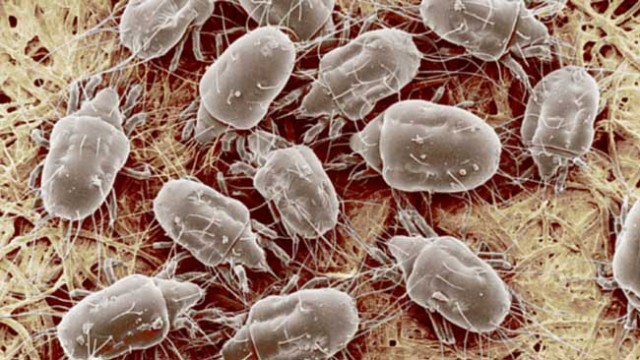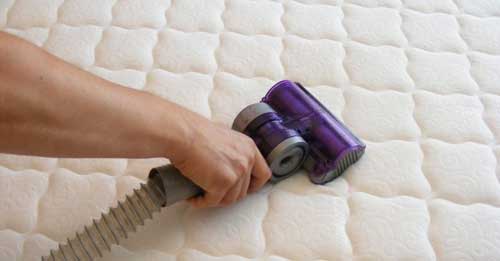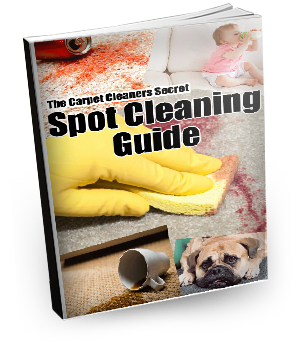If you’ve ever wondered how to get rid of dust mites, what exactly they are and how their presence can affect you. Then this article is for you.
Dust mites, unfortunately for people who suffer allergies, are everywhere.
They are found throughout the home, but are so small they are invisible to the naked eye.
On average about 25% of the population will return a positive skin prick reaction to dust mite allergens. Of this 25%, about half of them will go on to suffer an allergic reaction of some sort.
This allergic reaction is not to the dust mites themselves, but their microscopic waste products.
It is these tiny droppings and the fungus that grows on them, that cause so many health issues for people.
Now while it’s impossible to completely eradicate these tiny creatures from your home. There are some steps you can take to minimize their effects on you and your families health.
By understanding as much as you can about these tiny creatures from information in this article. You’ll be able to put together a strategy to control them that suits you and your situation.
What do Dust Mites Look Like?
Dust mites, together with spiders, scorpions and ticks comprise a class of invertebrates called Arachnids. Contrary to common belief they are not insects because they have 8 legs (insects have 6).
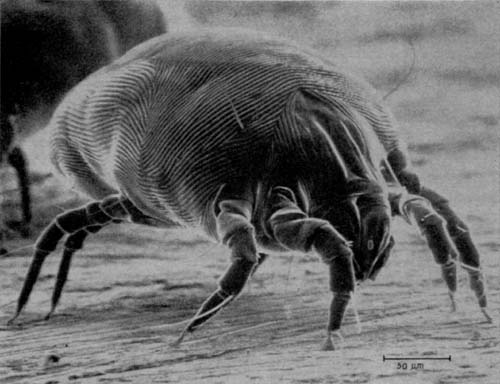
There are 2 main species, these are:
- The European house dust mite (Dermatophagoides pteronyssinus)
- The American house dust mite (Dermatophagoides farinae)
Despite their names they aren’t restricted to only Europe or North America. They are found in many different countries throughout the world.
Australia tends to predominantly play host to the European dust mite.
One of the big misconceptions about dust mites though, is that they are parasites. This of course is untrue. They don’t burrow into the skin, bite or sting and are generally harmless to most people.
The only real harm is that they breed quickly and thrive in warm humid conditions.
Once their populations explode, then the amount of waste products produced also increases. It is these waste products, and the mold that grows on them, that affects people who are susceptible to allergies.
Where do Dust Mites Live?
Dust mites are scavengers that feed on decomposing matter. For this reason they love to live anywhere that they can feed on dead human skin cells and dander from animals.
Because they thrive in moist and warm environments it hardly comes as a surprise to find them in huge numbers in mattresses, pillows and bedding. They are also found in carpet, upholstered furniture and curtains as well.
Depending on it’s age a typical mattress can have anywhere from 1 to 10 million dust mites living in it. This is why regular mattress cleaning is so important.
Imagine how much allergy producing waste products that lot would produce! Especially when each bug produces about 1000 particles of waste during its 80 day life cycle.
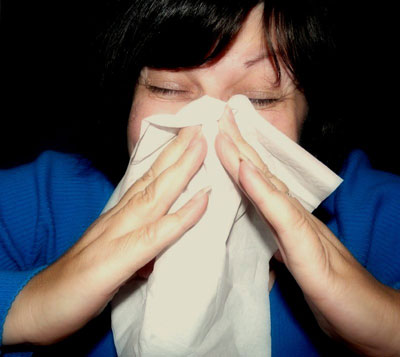
In this study carried out in 2005 by the University of Manchester. They found up to 16 different types of fungi living in synthetic and feather pillows of varying ages.
Is it any wonder that people get so sick from allergic reactions and asthma.
Life Cycle of the Dust Mite.
The lifespan of a male Dust mite is about 10 – 19 days but the female once mated can survive for up to 70 days. Over this time she will lay between 60 to 100 eggs. All within the last 5 weeks of her life.
There are five distinct stages in the life cycle, the egg, a larval stage, 2 nymph stages and finally the adult. This complete life cycle is about a month.
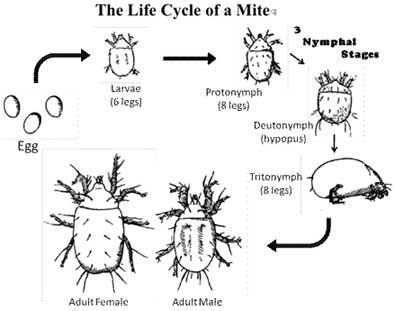
When conditions are favorable, humidity is high and temperatures warm. Dust mite populations can explode.
Dust Mites and Allergy.
Even though the thought of millions of dust mites being present in your bedding is not a pleasant one. As I stated earlier, dust mites themselves are harmless. It is their waste products and the fungi that grow on it that cause all the problems for allergy sufferers.
Typical symptoms of dust mite allergy are:
- Runny nose
- Itchy, Watery eyes
- Sneezing
- Coughing
- Eczema and skin rashes (especially in infants)
- Hay fever
- Asthma and shortage of breath
- Nasal congestion
- Allergic Rhinitis
- Itchy nose or throat
- Sinusitis
As you can see from the list above, the number of allergies attributed to dust mite allergens is extensive. It is for this reason it is absolutely essential to try controlling dust mites populations as much as possible.
If you suffer any of these symptoms you should consult your doctor. He/she can perform a skin prick and blood tests to determine if you are allergic to dust mite allergens.
It is impossible to completely eradicate dust mites because of their short breeding cycle and sheer numbers of eggs laid by the adults. However, if regular cleaning practices are put in place combined with dust mite control treatments. The effects of the allergens can be dramatically reduced.
Prevention and Control.
Beds are an absolute haven for dust mites and mattresses and pillows have the highest concentrations in the home.
Bedding provides warm and moist conditions ideal for populations to breed up quickly.
Carpets, upholstered furniture and curtains are also ideal breeding areas for dust mites. These should be professionally cleaned using a Hot water extraction method (steam cleaned). This should then be followed up with a suitable dust mite control treatment.
Pets should also be kept off the carpets, upholstery and bedding as much as possible (dust mites love pet hair and skin flakes).
2 factors that really influence the rapid growth of dust mite populations are:
- Humidity – 50% or greater
- Warmth – 20c (70 F) or above.
Air conditioning and de-humidifiers should be used to make the conditions for dust mites as unfavorable as possible.
Interestingly, and good news for those who hate making their bed in the morning. Leaving it unmade can make a big difference.
A study in 2005 by the Kingston University in the UK showed that exposing the bed sheet to the air, allowed any moisture in the sheets to dry out. This substantially reduced the number of dust mites in the bed.
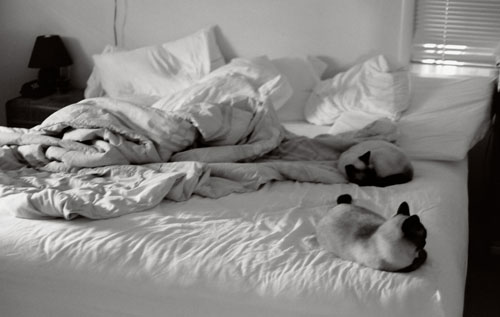
Though I’m not sure the cats would help the mite situation in this example.
Below is a list of measures that will help to prevent dust mite population buildup and exposure to allergens:
- Sheets and blankets should be washed every 2 weeks in hot water (+55 degrees C)
- Pillows should be washed every week or once a year if they have dust mite proof covers.
- Use synthetic fillers rather than feathers or down
- Use mattress and pillow covers
- Put pillows, quilts and mattresses out in the sun weekly if possible
- Regular vacuuming of mattresses, carpets, upholstery and curtains.
- Regular vacuuming of children’s stuffed toys. Wash them if possible.
- Place any articles that can’t be washed in the freezer for 24 hours.
When vacuuming make sure you have a vacuum cleaner with a HEPA filter, otherwise the fine particles that cause allergy will be sucked up and re-dispersed through the air.
Not a good idea if you are allergic to them!
How To Get Rid Of Dust Mites
Unfortunately you will never be able to completely rid yourself of dust mites. They just breed too quickly and as we have seen the females can lay a lot of eggs in a short amount of time.
You only need one pregnant female dust mite and the population starts up again.
Typically after steam cleaning your carpets and upholstery, dust mite populations will be reduced by about 80%- 90%. However they will be back to pre-cleaning levels within about 3 months, so you’ll need some kind of dust mite carpet treatment.
Now the good news is, there are a variety of products out there in the market place, that can reduce dust mite numbers dramatically. Some of these target the mites and their larvae, while others act upon the waste matter, neutralizing the actual allergens.
There are basically 3 different types of products used for killing the actual dust mites. These fall into 1 of the 3 categories below:
- Fumers and foggers
- Powders
- Sprays
So lets take a look at 5 of the best of these types of products that are currently on the market.
1. Mini Fortefog ‘P’ Fumer Smoke Generator
A Mini fumer (3.5 g) that will treat up to 120m. Simple to use in the home, factory or warehouse.
- Effective against a wide range of flying and crawling insects including Dust Mites.
- Leaves no visible deposit after use.
- Very useful where spraying access is difficult.
- Contains 13.25% Permethrin in a special Agropharm formulation.
2. Ecology Works Dust Mite and Flea Control Powder
This powder works by coating the food source of the mites. It then enters their bodies and kills them by dehydrating them.
- Patented treatment that kills dust mites and fleas
- Formulated Borate Compound
- Easy to use – just mix with water – treats 800 sq ft as spray, or 400 sq ft in steam carpet cleaner
- EPA registered – low toxicity with insignificant exposure risk to humans
3. Sprayway SW003R Good Night Aerosol Spray
A ready-to-use product that can be sprayed on bedding, furniture and carpets.
Kills dust mites and is safe to use on pillows, sheets and mattresses.
- 160z Aerosol spray
- Kills dust mites, ticks, fleas, bed bugs and lice
- Easy to use
4. X-Mite Anti-Allergen Moist Powder Carpet Cleaner
A 2 in 1 Dust Mite and anti allergen treatment. Use a broom to brush the treatment into the carpet. Let the treatment sit for three hours. Remove by vacuuming
- Cleans WITHOUT Water, Shampoo or Steam meaning no wet carpet and no sticky residue left behind
- Its special formulation contains tannic acid to neutralize environmental allergens
- Environmentally safe product for use around people and pets.
5. DustMitex Pre-Mixed Spray
This pre-mixed spray from The Ecology Works is a long-lasting treatment that eliminates dust mites and fleas from carpets and upholstered furniture and keeps them away naturally!
- 32-oz spray bottle
- One bottle covers up to 100 sq. ft
- Safe to use on pet bedding and mattresses
- Lasts at least up to 6 months before you have to reapply
Beware the Scams
Because so many people suffer from allergy problems. The allergy prevention industry is a huge one. This inevitably brings with it the problem of scammers and sales people prepared to lie about their products.
One thing I would be very wary of is any individual or company that makes the claim that they can eradicate your dust mite problem.

If you’ve read through the whole of this article you’ll now know that this is impossible because of how quickly they can breed.
Dust Mites can NEVER be 100% eradicated!
So lets take a look at some of the more questionable services and claims that are out there.
Duct Cleaning
Now this is possibly worthwhile for the removal of dust buildup and mold spores if you have had a major water damage problem in your home. But to claim it is an effective method for controlling dust mites is questionable.
For starters the dry environment of a heating or cooling duct is not the kind of environment where mites like to settle and breed. They need fibrous, warm and humid conditions. There may of course be some that are carried by the air up into the ducts, but as far as them being a major problem…
I very much doubt it!
So be careful if approached or sent out any information in regards to this type of business. Make sure you check exactly what their claims are.
If they have a picture of a dust mite on their advertising material and are focused around dust mite eradication.
Be very very skeptical.
UV Mattress Sanitizing Treatments
There are a number of companies out there now that will come to your home and clean your mattress using either ultraviolet-C light.
Once they have supposedly killed all the mites with the UV light. A high powered vacuum is then used to remove the dead mites and their fecal matter from the mattress.
There is not a lot of scientific data in regards to this method. There is one claim from US based Hygenietech Inc who apparently have had the method scientifically tested. They claim that the process removes about 98% of mites and debris.
Again though. the real problem lies in the claims made when you are being sold this type of service. If they claim they can completely eradicate your mite problem.
Then you know they are either misinformed or bending the truth.
Carpet and Upholstery Cleaning
This is one area where false claims and misconceptions in regards to dust mites are regularly made. The belief seems to be that hot water or steam are enough to purge everything from a carpet and leave it sanitized and mite free.
Short term this may be the case and getting your carpets cleaned regularly is certainly an essential part of a dust mite management plan.
The fact is that even after getting your carpets cleaned with the Hot Water Extraction method. Give it about 3 months and the mite numbers will be right back where they started. Using the dry cleaning method its even less, probably a couple of weeks at best.
You can read about the different types of carpet cleaning methods here.
You can increase the amount of time that your carpets or upholstery remain relatively dust mite free. Products like Ecology works DustMite & Flea Control powder works really.
It is rinsed through the carpets or upholstery after cleaning and dries on and in the fabric. It actually coats their food source (flakes of skin) and desiccates and kills them.
This will significantly lower dust mite populations in carpets for about 6 months and then needs to be re-applied.
If your carpet cleaner is not doing this but claiming that the cleaning method alone is enough to eradicate your dust mite problem.
Well you know what to tell him after reading this article eh?
Conclusion
Allergies are a huge problem these days and really cripple a lot of people.
Hopefully this article has given you a pretty good understanding of the role dust mites play in that situation.
You should also now have a good knowledge of what exactly dust mites are. Where they live, what they feed on, how fast they breed and what products and methods are available to control them.
Remember also if someone claims they know how to get rid of dust mites completely, then they are probably looking to scam you in some way or another.
Have you had an experience with bad allergy around your own home and was it due to dust mites? What was your solution and experience, I’d love to hear about it!

